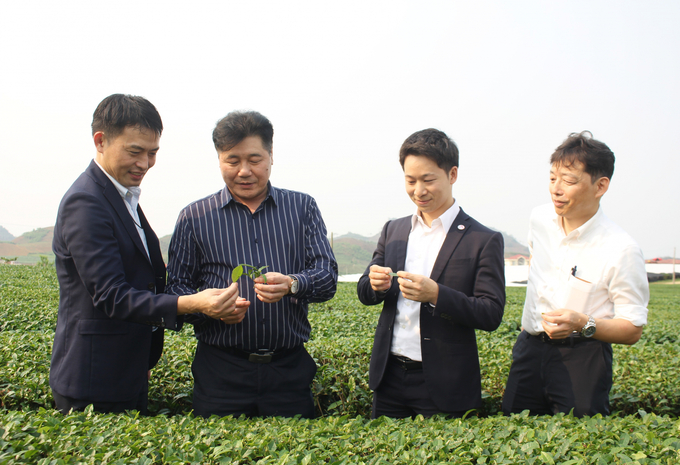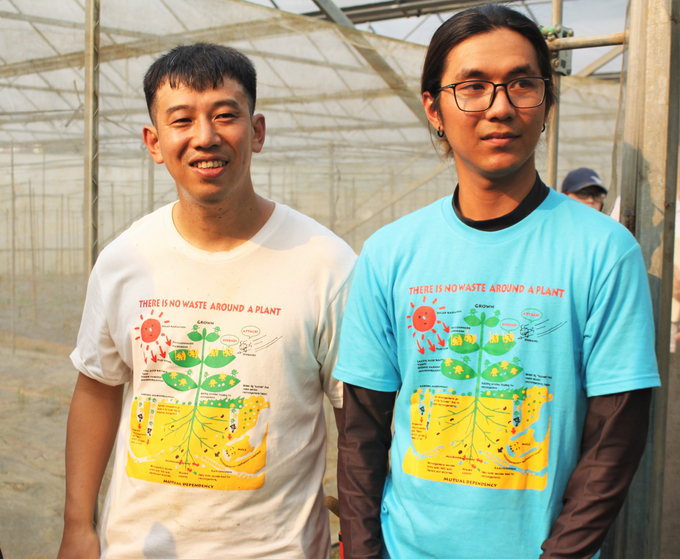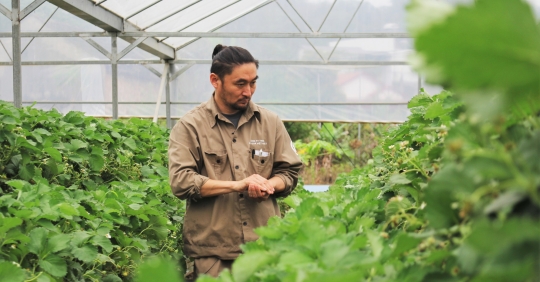[ad_1]
SON LA In Son La, many safe and ecological agricultural production models from units and companies from Japan are valuable experiences for local farmers.
In Son La, the National Agriculture Extension has just coordinated with the Department of International Cooperation (MARD) and the Japan International Cooperation Agency (JICA) to organize a seminar on “Organic Agricultural Production” in Japanese Technology in Vietnam” and visited and exchanged knowledge and experiences in safe agricultural production along the value chain at Japanese companies and farms in Van Ho and Moc Chau (Son La) districts.

Delegates actively discussed and shared experiences on safe agricultural production at the Japanese Technology Organic Agricultural Production Seminar in Vietnam. Picture: Lighthouse.
This is one event in the series of activities of the project “Strengthening the Safe Crops Value Chain for the Northern Provinces of Vietnam” funded by the Government of Japan through the Ministry of Agriculture, Forestry and Fisheries of Japan and developed by JICA. The Ministry of Agriculture and Rural Development of Vietnam has commissioned the National Agricultural Center to lead the project implementation.
This activity in Son La aims to provide opportunities for cooperatives, as well as local agricultural advisors directly involved in and supporting the project implementation, to observe the reality and learn from experiences.Japanese companies can continue the production of safe products along the increase value chain. At the same time exchange about challenges and difficulties as well as ideas and solutions for the development of sustainable agriculture in Vietnam.
Closed production to protect the Japanese tea brand
As part of the program, delegates visited the closed-loop green tea and matcha tea production chain at Satoen Vietnam Co., Ltd.’s Japanese tea factory. (Sao Do 2 Sub-area, Van Ho Township, Van District, Lake). It is the first high quality Japanese tea and matcha tea factory outside of Japan.
Here, delegates visited and shared experiences on growing tea in the company’s nearly 52-hectare raw material production area, using Japanese tea varieties cultivated under a strict self-government process under the company’s supervision. Supervision by Japanese experts and well-trained staff on site. The production process is completed using modern and high-tech equipment. The company has used netting to keep the tea leaves fresh and green to make matcha tea (this is a method few units use).

Mr. Le Quoc Thanh, Director of National KNOWLEDGE Center (2nd from left) and representative of JICA Vietnam visited the production area of Japanese tea ingredients of Satoen Vietnam Co., Ltd. Picture: Lighthouse.
All products are thoroughly quality tested by the Satoen Institute of Food and Drugs and the National Institute of Food Safety and Hygiene.
The company also set up a processing factory right in the center of the tea garden with a green tea production line with a capacity of 2 tons/day, producing matcha tea with 2.5 tons of raw materials/day. The young tea buds are processed immediately after harvesting in order to preserve the characteristic taste of Japanese tea.
According to Mr. Sato Kimihico, President of Satoen Vietnam, organizing production in a closed chain will make it easier to control the entire process from production to processing and consumption of the products. At the same time, it is easier to use modern technologies and advanced cultivation methods. This improves productivity and performance and reduces production costs.
Agricultural production respects nature
At Nico Nico Yasai Organic Vegetable Farm in Van Ho City (Son La), the delegates present were impressed by the enthusiasm, diligence and farming philosophy of “There is no waste around a plant” (nothing is left around the plants). by two boys Shiokawa Minoru (Japan) and Nguyen Phuoc Sinh (from Buon Ma Thuot, Dak Lak).
Farm owner Shiokawa Minoru shared: The organic vegetable farm in Van Ho has an area of more than 2,500 m2, divided into greenhouses, net houses for growing tomatoes, potatoes, peppers, onions…

The agricultural philosophy “There is no waste around a plant” by the two boys Shiokawa Minoru and Nguyen Phuoc Sinh from Nico Nico Yasai Organic Vegetable Farm made a strong impression on the delegates present. Picture: Lighthouse.
Nico Nico Yasai’s company motto is “Agricultural production must respect nature, develop food sources and create the best products with special value”. Therefore, in the production process, the farm always values all agricultural waste and turns it into the best source of nutrients for plants. Can be mentioned as a preparation of ginger, garlic, chili… in preparations to increase the resistance of plants and repel insects. Use natural enemies to protect plants. Use the discarded stems and leaves to soak them in probiotics and compost to make fertilizer. In case the plant is exposed to serious diseases, it will be uprooted and no attempt will be made to cure it with chemicals….
According to Mr. Shiokawa Minoru, all inputs such as seeds, irrigation water, fertilizers, etc. must be strictly controlled to produce organic vegetables. The cultivation process must be done manually, absolutely “no” to pesticides and chemical fertilizers.
In addition, it is more important that the person who produces directly must bring a spirit of love for the environment, hard work, perseverance, creativity, dynamism and solidarity in order to succeed. Because with natural and organic production, the yield is usually only 60% of conventional production. Product design is not beautiful. The Vietnamese still cannot identify with safe products and behave properly, so the sale price of the products is higher, but there is still no difference with products of the same kind from normal production. The production process takes a lot of time and money.. .
Strict control of all production stages
At Viet Nhat Fruit and Vegetable Company’s strawberry farm in Bua Village, Dong Sang Township (Moc Chau), Mr. Nahana Shojiro, the company’s director, shared his experience of growing strawberries safely and economically.
According to Mr. Nahana Shojiro, in order to produce high-quality and safe strawberry products and save on production costs, each step in the production process must be carried out carefully.

Mr. Nahana Shojiro’s strawberry farm has been successful with the application of advanced cultivation techniques. Picture: Lighthouse.
On average, strawberry plants can be harvested for up to 6 years. However, the highest yields usually fall in the first and second year. Therefore, if you can maintain the exchange of seedlings once a year, then the yield and yield will be optimal.
To take the initiative in seedlings, the company built a system of greenhouses for separate propagation. A clonal propagation method is used by the parent plants to preserve the quality of the genetic resources.
In terms of care, strawberry is a plant that is very susceptible to many diseases, where anthracnose is a difficult disease to treat and can cause mass deaths.
To completely solve this disease, the farm built each tank closed, leaving only a single outlet for water. Then use rice bran to mix it with the soil, pump it with water, cover the surface with plastic to confine the air and keep the temperature (always keep the temperature between 30 and 50 degrees Celsius) . Before sowing, soak the soil for at least 1 month to kill any pathogens.
According to Mr. Nahana Shojiro, this method is quite expensive, but the effect is very good, as evidenced by the fact that his farm has not experienced the dead tree phenomenon due to anthracnose disease for the past 2 years.
As for harmful spiders, there are quite a lot of spiders due to the long harvest season and the cultivation of strawberries in the web house. He used the “spider eats spider” method. He contacted Dalat Hasfarm Co., Ltd. to purchase natural hostile spiders to breed. This spider helps destroy destructive spiders without using pesticides, but the efficiency is several times higher.

Safe agricultural practices on Japanese farms have inspired many ideas for Vietnamese cooperatives. Picture: Lighthouse.
In addition, to improve soil nutrition, he used rotted rice husks with probiotics for fertilization instead of using chemical fertilizers.
With this method, the company’s strawberry fields grew and developed very well. On average, the company sells about 14 tons of strawberries on the market every year. Products are made where they are bought.
After witnessing with his own eyes and sharing experiences with Japanese farm owners, Mr. Ha Van Son, director of Chieng Hac Safe Agriculture Cooperative (Chieng Hac, Yen Chau), excitedly shared: Although trees are mango, the main crop of the cooperative is Mango, but methods of soil improvement, use of by-products as fertilizer, use of natural enemies, environmental treatment of production and processing areas … of the crops have been inspected, can be fully applied to mango trees in particular, other crops in general, to create quality products .
According to Mr. Le Quoc Thanh, director of the Center for National Agriculture, the project “Strengthening the Value Chain of Safe Crops for the Northern Provinces of Vietnam” has many innovations in terms of design, which is an approach to building a value chain. treat. The actors involved in the chain are cooperatives and agricultural advisory systems.
In addition to building capacity for cooperatives, the project also strengthens the capacity of agricultural advisors and stakeholders in the safe crops value chain. This is a sustainable approach to train highly qualified human resources with specialized knowledge and skills needed to meet the requirements to strengthen enforcement capacity to ensure food safety.
[ad_2]
Source link

